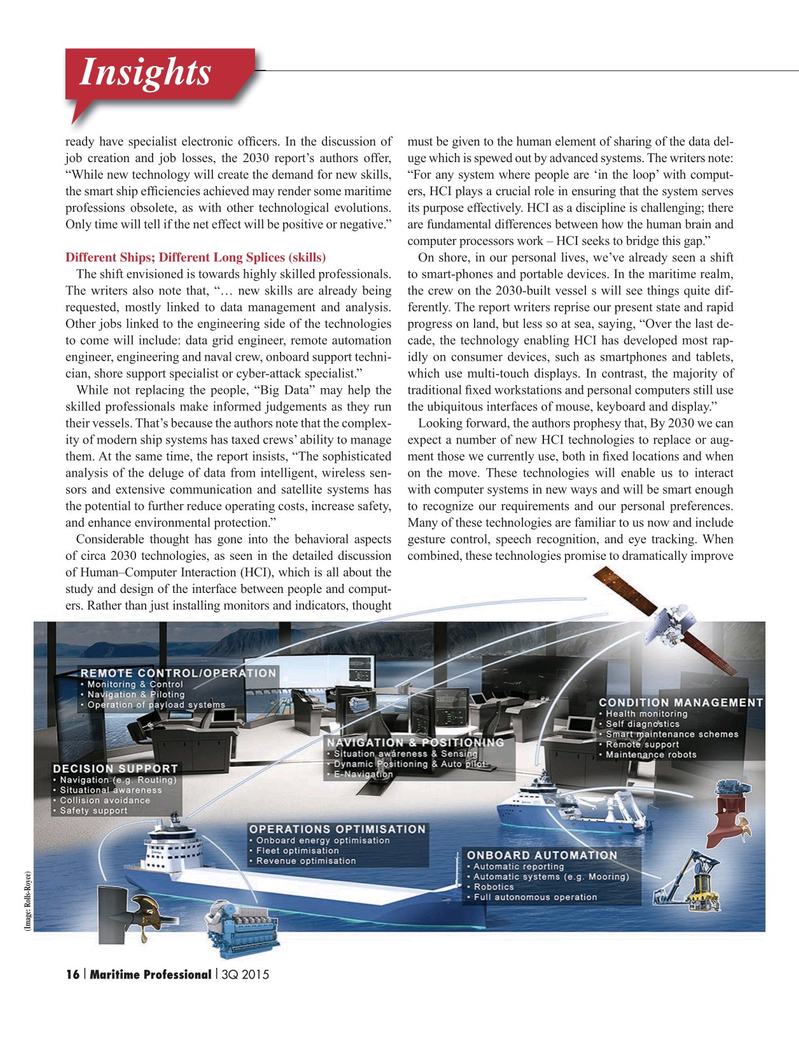
Page 16: of Maritime Logistics Professional Magazine (Q3 2015)
Read this page in Pdf, Flash or Html5 edition of Q3 2015 Maritime Logistics Professional Magazine
Insights ready have specialist electronic of? cers. In the discussion of must be given to the human element of sharing of the data del- job creation and job losses, the 2030 report’s authors offer, uge which is spewed out by advanced systems. The writers note: “While new technology will create the demand for new skills, “For any system where people are ‘in the loop’ with comput- the smart ship ef? ciencies achieved may render some maritime ers, HCI plays a crucial role in ensuring that the system serves professions obsolete, as with other technological evolutions. its purpose effectively. HCI as a discipline is challenging; there
Only time will tell if the net effect will be positive or negative.” are fundamental differences between how the human brain and computer processors work – HCI seeks to bridge this gap.”
Different Ships; Different Long Splices (skills) On shore, in our personal lives, we’ve already seen a shift
The shift envisioned is towards highly skilled professionals. to smart-phones and portable devices. In the maritime realm,
The writers also note that, “… new skills are already being the crew on the 2030-built vessel s will see things quite dif- requested, mostly linked to data management and analysis. ferently. The report writers reprise our present state and rapid
Other jobs linked to the engineering side of the technologies progress on land, but less so at sea, saying, “Over the last de- to come will include: data grid engineer, remote automation cade, the technology enabling HCI has developed most rap- engineer, engineering and naval crew, onboard support techni- idly on consumer devices, such as smartphones and tablets, cian, shore support specialist or cyber-attack specialist.” which use multi-touch displays. In contrast, the majority of
While not replacing the people, “Big Data” may help the traditional ? xed workstations and personal computers still use skilled professionals make informed judgements as they run the ubiquitous interfaces of mouse, keyboard and display.” their vessels. That’s because the authors note that the complex- Looking forward, the authors prophesy that, By 2030 we can ity of modern ship systems has taxed crews’ ability to manage expect a number of new HCI technologies to replace or aug- them. At the same time, the report insists, “The sophisticated ment those we currently use, both in ? xed locations and when analysis of the deluge of data from intelligent, wireless sen- on the move. These technologies will enable us to interact sors and extensive communication and satellite systems has with computer systems in new ways and will be smart enough the potential to further reduce operating costs, increase safety, to recognize our requirements and our personal preferences. and enhance environmental protection.” Many of these technologies are familiar to us now and include
Considerable thought has gone into the behavioral aspects gesture control, speech recognition, and eye tracking. When of circa 2030 technologies, as seen in the detailed discussion combined, these technologies promise to dramatically improve of Human–Computer Interaction (HCI), which is all about the study and design of the interface between people and comput- ers. Rather than just installing monitors and indicators, thought (Image: Rolls-Royce) 16 Maritime Professional 3Q 2015I I 1-17 Q3 MP2015.indd 16 9/18/2015 3:14:59 PM

 15
15

 17
17
